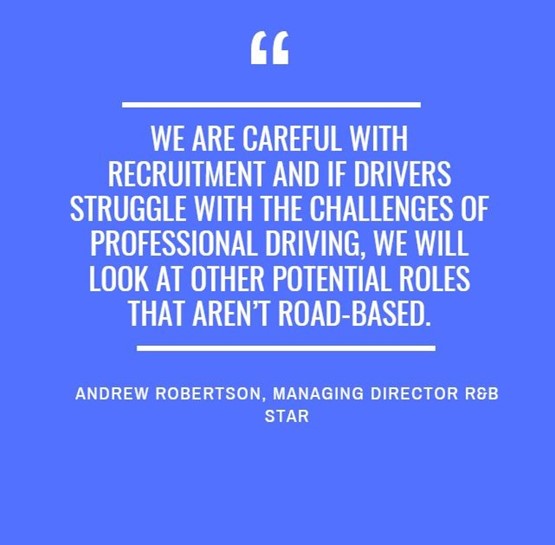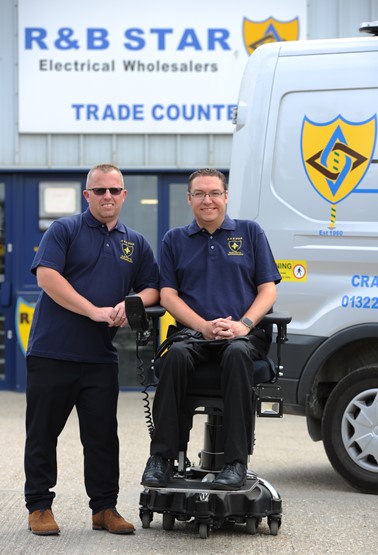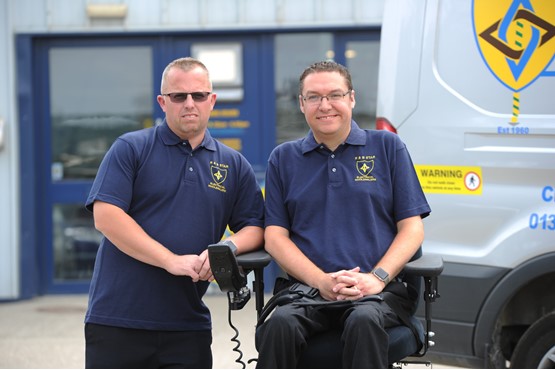Safety has been a priority at family-owned R&B Star for three generations, says Andrew Robertson. By John Maslen
Company culture can be an important factor that determines how a fleet and its drivers are managed.
If safety comes second to hitting sales targets among senior management, this can be reflected in a poor accident record that can prove costly when it comes to reviewing annual profits.
At R&B Star, running a safe and efficient fleet has been a management priority since the electrical wholesaler was formed in 1961.
Through three generations of the Robertson family, the business has steadily grown and now has a turnover of £16.5 million, serving customers from three distribution centres in and around London.
Current managing director Andrew Robertson says: “The business was started with £250 by my grandfather and his business partner.
“As the business grew, we took on more staff and, given it is a family business, it is built on a philosophy of treating staff in the way you would want to be treated yourself.”
This includes keeping drivers safe on the road, which, Robertson says, was a personal commitment of his father Bob as he built the company.
Robertson adds: “My father drove vans when he first worked with my grandfather, learning the business from dispatch upwards.
“He was very clear that the van is a driver’s office and workspace. If employees are going to be sitting in a van all day, it is never a saving to scrimp on a van and then expect to get the best from a driver.”
The company operates a fleet made up mainly of Ford Transits, which provide the best balance of cost-efficiency and payload for the business, he says.

Carrying capacity has been a factor in moving away from another manufacturer after a new model had a reduced payload compared to the outgoing variant.
As the business has tens of thousands of items in stock, van bulkheads have been modified to take longer items, meaning the variety of stock that can be carried in vehicles is extensive.
The commitment to driver comfort and safety is evident when the company specifies its vehicles.
R&B Star recently added two new Ford Transits to its fleet, taking the total fleet to 13, with each one specified with auto stop/start, built-in sat-nav, reversing cameras and air conditioning.
However, the high level of specification isn’t just driven by a commitment to driver welfare.
An increasing number of the company’s contracts include clauses relating to vehicle condition and specification, especially when site access is required.
R&B Star has had supply arrangements with some of the country’s biggest industrial contracts, including construction of the Thames Tideway tunnel and the new Crossrail railway line serving London.
To meet contractual commitments, vans are also fitted with LED loading lights, reversing alarms, amber flashing roof bars and additional safety lights for on-site visibility.
R&B Star has also achieved Fleet Operator Recognition Scheme (FORS) Silver accreditation, which is another critical element of some contracts as customers extend their safety focus to third-party suppliers.
FORS Silver requirements include proof of effective driver licence verification systems, while vehicles weighing more than 3.5 tonnes need to be equipped with a left turn audible warning system and blind spot minimisation devices.
The FORS scheme, which encompasses safety, fuel efficiency, vehicle emissions and improved operations, fits well with the company’s values and is something everyone at R&B Star is committed to, Robertson adds.
The fleet is run by operations director Glenn Robertson, Andrew’s cousin, who says: “FORS Silver demonstrates our commitment to good practice and enables us to support our customers on important projects.
"FORS has helped our approach to fleet management, staff development and given us access to relevant training. We are now working towards FORS Gold.”
Andrew Robertson adds: “Contract requirements are driving up standards. Those prepared to invest in it gain a competitive advantage, as other wholesalers are not prepared to make the investment to qualify for contracts.

“It is not HGV level, but it is good to show our staff we really care about them and when it comes to safety, you can never go far enough.”
Drivers have taken part in the FORS Van Smart Training programme, which is endorsed by the Driver and Vehicle Standards Agency and aims to create long-term behaviour changes by bringing about professionalism among drivers.
It follows research which found that vans account for 80% of all road freight mileage in London, with 10% of road traffic incidents involving a van, of which 11% result in a serious injury or fatality.
Elements of the scheme include a driver handbook, toolkit for managers, toolbox talks and safety-focused posters.
The programme has helped drivers gain a new perspective too, with R&B Star employees cycling around London as part of their training to understand the views of other road users.
Andrew Robertson says: “It makes you proud that the drivers were doing things properly and taking the safety of other road users seriously.”
The safety-first approach at R&B Star begins with recruitment, as interviews are focused on ensuring drivers are right for the role.
“We have had a couple of years where there have been virtually no claims,” Robertson says.
“That was down to the fleet manager spending time and making sure we had the right drivers. We are careful with recruitment and if drivers struggle with the challenges of professional driving, we will look at other potential roles that aren’t road-based.
“We have had a couple of drivers taken out of vehicles because they didn’t understand that driving is a specialist skill.
“We also operate with one employee to one van, as we like drivers to take ownership of the vehicle. They are proud of their vehicles and tend to look after them.”
There is a focus on peer-to-peer training to share best practice, but although drivers are trusted, the business recognises the potential benefits of new technology and was one of the first to introduce telematics in the 1990s.
Andrew Robertson says: “People thought we were crazy but being able to tell customers where vehicles were was valuable and it took distraction away from drivers as we didn’t have to call them to identify their location.”
With a focus on constant innovation, the company is experimenting with dashboard cameras and is looking at a fleet management system that can automate routing and scheduling, although Robertson is careful to ensure employees are comfortable with planned changes and gets them used to ideas before moving forward.

This includes the introduction of in-van weighing equipment (it already has a depot-based system), as drivers contend their experience is enough to know if a van is reaching capacity.
Drivers are also urged to report any defects immediately, as this can have a direct impact on their ability to deliver products to customer sites.
Andrew Robertson says: “With these contracts, if something goes wrong with the vehicle, then they won’t let you on site. I have a driver whose flashing lights stopped working on the way to a delivery and they turned him away.
"So, we are clear with drivers that if something goes wrong you need to tell us straight away.”
One challenge of maintaining such a focus on high standards of training can be agency drivers, who may only be with the business for a short time, but Andrew Robertson believes it is a cost that the business just has to accept, adding:
“It can be difficult with agency drivers. There is a lot of online training and it takes them half a day to do the online training and half a day to do the online assessment.
”Overall, the investment in safety is value for money, especially when we see the focus on training and driver development leading to lower accidents and vehicle downtime.”
The fleet consists of light commercial vehicles but has previously looked at the potential savings from upgrading to 7.5-tonne trucks.
This was particularly useful for large contracts, such as during the building of the new Wembley stadium.
However, the decision was taken to remove the lorry from the fleet, as the level of use did not justify the administration and training involved with operating a larger vehicle which required an O-licence.
In addition to the Ford Transits, the business has a small number of Toyota Hiace vans which are used as pool vehicles for urgent deliveries.
They provide the best balance between a car and a van if they are used by a member of staff who is not experienced in driving a commercial vehicle, although these are being phased out as ongoing contracts tend to make delivery requirements more predictable.
Vehicles are typically bought outright through a hire purchase arrangement, and are run for four years or 150,000 miles, which means that disposal strategies can be decided by the business.
This allows for innovations that might not be possible in a larger company.
During a fundraising campaign for muscular dystrophy the fleet played a central role.
Historically, the business sold de-fleeted vans direct to a dealer, but a member of staff, who was part of a team from the business climbing Mount Kilimanjaro in Tanzania to raise funds for the charity, asked to take over the sales process, suggesting they could get a better price, in return for half the improved revenue being handed to the charity.
Andrew Robertson, who suffers from the genetic muscle-wasting condition and uses a wheelchair, says: “With the dealer, we would come away with a reduced price, but it was straightforward.
“With direct sale, we raised thousands of pounds extra from just a few vehicles. You do have to be careful because it isn’t wholesaling, so there is a focus on ensuring the vans are in good shape.
"You have to be careful to be honest and upfront about any issues.”
Sales were achieved either through direct contact from other local fleet operators who were looking for a van from a trusted source, or via sales sites including eBay.
The fundraising climb brought together staff throughout the company which employs more than 70 people.
Other community events include an annual black tie dinner, which raises money for muscular dystrophy, one of 10 charities the business supports, but also recognises the best drivers in the business.
A combination of factors is used to identify winners, including safety reports based on vehicle tracking data along with broader elements, such as employees going above and beyond the call of duty to help the business when issues occur.
The awards reflect the community spirit at R&B Star, with other events including an annual karting race. It also hosts regular networking meetings between suppliers, so they can potentially find new business opportunities.
Robertson says: “It doesn’t directly benefit our business, but it supports our suppliers and that means they can continue to support us.”
This includes its vehicle livery supplier, Sean Broad, who started out being mentored and assisted by the Prince’s Trust, when Andrew’s father, company chairman Bob Robertson, was a volunteer business mentor.
The Prince’s Trust is a charity that through education and training assists young people aged 11 to 30 to find or prepare themselves for employment.
Broad went on to create his own business, BroadSigns, and still provides R&B Star with its livery.
He has been profiled on the R&B Star website with a story about the value of vehicle livery when promoting a business.
Andrew Robertson adds: “It makes sense to support businesses that support you, so you know they are stable. It’s like an extended family.”

Still a long journey to electric avenue for R&B Star
A specialist electrical company would seem the perfect candidate for a shift to electric vehicles, but business realities currently prevent change.
R&B Star needs to maximise payload and range in its vehicles to meet customer delivery requirements for its thousands of product lines, which are delivered to locations including the south coast.
To date, there are no suitable alternatives to diesel engines, managing director Andrew Robertson says, although the company has looked at fuel-efficient choices for its company car fleet.
The car fleet has dwindled as drivers have taken the cash option, mainly because of rising benefit-in-kind tax bills, while the remaining five vehicles are Toyota and Lexus hybrids.
Robertson adds: “We already have solar panels on the roof of our building and, being an electrical wholesaler, when EVs become viable for commercial delivery fleets it would make sense to put in charging points.
“We are waiting for a major manufacturer to bring in something tried and tested that doesn’t affect the payload we require.”

















Login to comment
Comments
No comments have been made yet.